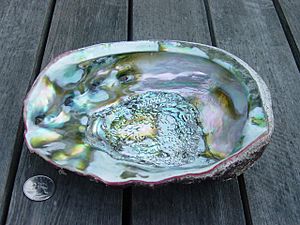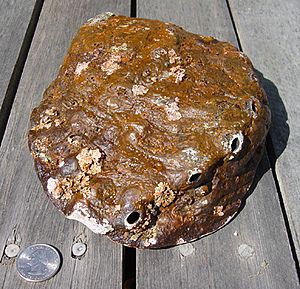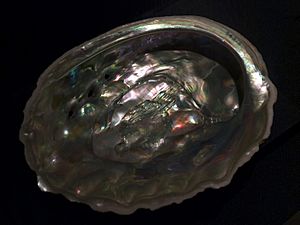Red abalone facts for kids
Quick facts for kids Red abalone |
|
|---|---|
 |
|
| Conservation status | |
| Scientific classification | |
| Synonyms | |
|
The red abalone (scientific name: Haliotis rufescens) is a very large, edible sea snail. It belongs to the family called Haliotidae, which includes all abalones. These snails are also known as ormer shells or paua in some parts of the world.
You can find red abalones along the coast from British Columbia, Canada, all the way down to Baja California, Mexico. They are most common in the southern areas of their range. In northern California, the red abalone is the biggest and most common type of abalone.
Contents
Where Red Abalones Live
Red abalones like to live in rocky areas where there is a lot of kelp. Kelp is a type of large seaweed. They eat different kinds of kelp that grow in their ocean homes. Some of these include giant kelp (Macrocystis pyrifera), feather boa kelp (Egregia menziesii), and bull kelp (Nereocystis luetkeana).
Young abalones eat smaller things. They munch on coralline algae, tiny bacteria, and diatoms. Red abalones can be found from the shallow areas near the shore to waters more than 180 meters (590 feet) deep. However, they are most often found between 6 and 40 meters (20 and 130 feet) deep.
What Their Shells Look Like
The shell of a red abalone can grow up to 31 centimeters (12 inches) long. This makes it the largest abalone species in the world!
The shell is big, thick, and shaped like a dome. It is usually covered with barnacles, plants, or other sea life. This makes it hard to see the shell's true color or its patterns. The outside of the shell is usually a dull brick red color.
Red abalone shells typically have three to four slightly raised oval holes. These holes are for breathing. Sometimes, shells are found with no holes or with more than four. These holes form a line called the selenizone as the shell grows bigger.
The inside of the shell is very shiny and colorful. It has a strong iridescent (rainbow-like) shimmer. You can easily see a large, clear muscle scar in the middle of the shell. This scar shows where the abalone's strong foot muscle was attached. Scientists have even studied the tiny way these shells create their shiny inner layer, called nacre.
Inside and Out: Abalone Body Parts
If you look closely, you can see the abalone's black epipodium and tentacles peeking out from under the shell's edge. The underside of its foot, which it uses to move, is a yellowish-white color.
Red Abalone Health and Diseases
Red abalones can get a serious disease called withering syndrome. It is also known as abalone wasting disease. This disease is caused by tiny bacteria-like organisms. In the past, this disease greatly harmed abalone populations.
Today, we don't fully understand how much withering syndrome affects current abalone numbers, but populations are still low. Warmer water temperatures can make the disease spread faster and become more severe. Abalones that are exposed to the disease and are starving in warmer water (18.0 °C or 64.4 °F) are much more likely to get sick than those in colder water (12.3 °C or 54.1 °F). This was shown in a 2005 study. It was the first time scientists proved that temperature affects how this disease spreads.
How People Have Used Red Abalones
People have used red abalones for a very long time, even before recorded history. Red abalone shells have been found at ancient sites on the Channel Islands that are nearly 12,000 years old. Large piles of red abalone shells, called middens, are common at archaeological sites on the Northern Channel Islands. These piles date back between 7,500 and 3,500 years ago.
The Native American Chumash people also collected this species along the Central California coast long ago. The Chumash and other California Native Americans used red abalone shells to make many things. These included fishhooks, beads, ornaments, and other tools.
A History of Abalone Diseases
In the 1980s, a worker from the California Department of Fish and Wildlife was raising abalone privately. They brought in some South African abalone (Haliotis midae) but did not keep them separate from other abalone. With these abalone came a new worm called Terebrassabella heterouncinata. This worm was not native to the area.
The worm escaped into the ocean near Cayucos, California, where an abalone farm was located. It also spread to many other places in the wild. Scientists from the University of California, Santa Barbara and the Department of Fish and Wildlife worked with the abalone farm staff and volunteers to get rid of this pest.
Soon after this, another abalone disease appeared on Santa Cruz Island. It spread to the other Channel Islands of California and to the California mainland. This bacterial disease was very harmful to both wild and farmed abalone. It was named "withering syndrome" because the abalones would starve even when there was plenty of food. This happened because the bacteria infected the abalone's digestive system. It stopped them from digesting and absorbing kelp, which is their main food. The bacteria belong to the family Rickettsiaceae.
Withering syndrome first appeared a few years after the South African abalone were brought to California. It started near Smugglers Cove on Santa Cruz Island. This was close to an area where seaweed was collected for an abalone farm at Port Hueneme, California. The disease spread even more because the Department of Fish and Game moved infected abalone into the wild north of Point Conception.
This bacterium attacks several types of abalone. It causes the abalone's internal organs and foot muscle to shrink. This makes the abalone weak and unable to move or turn itself over if it gets flipped. The disease is deadly.
Withering syndrome, too much fishing, and losing their homes have caused black abalone and white abalone to be listed as Endangered Species. The United States Fish and Wildlife Service plans to start a program to bring abalone back. Withering syndrome has affected all abalone farms in California at some point. It has also spread to Iceland and Ireland because infected California Red Abalone (H. rufescens) were sent there.
Abalone sent to Israel before the South African abalone came to California did not have withering syndrome. Black abalone, red abalone, green abalone, white abalone, and two other abalone species have almost disappeared from Southern California because of withering syndrome. However, the populations in Northern California have stayed larger because the water is colder there. Green abalone and white abalone are not common in Northern California now. They used to be plentiful in Southern California. Black abalone might even disappear completely very soon.
Abalone Farming
Because most wild abalone populations have been harmed, abalone farming has become a big business. Unlike some types of fish farming, raising abalone is seen as a way to farm sustainably. This means it is good for the environment. Few chemicals are used, and the abalone are fed kelp that is harvested nearby. This kelp grows back quickly. Some algae is also grown just for feeding the abalone.
Wild Abalone Fishing
Modern fishing records for California abalone began in 1916. Fishing for these abalone populations was highest in the 1950s and 1960s. After that, the numbers of all five abalone species (red, green, pink, white, and black) started to decline. Before this decline, fishing seemed sustainable. More species could be fished, and fishing areas expanded. However, disease and the return of sea otter populations (which eat abalone) led to the abalone's decline. The California Fish and Game Commission stopped abalone fishing in 1997.
In Northern California, however, commercial fishing was only allowed for three years during World War II. Because of this, people can still fish for abalone for fun in northern California. Scuba diving to collect abalone is not allowed. So, people either search the rocks at low tide or free dive (hold their breath) to find them. This rule helps protect abalone in deeper water (below 30 feet or 9 meters). Few divers are skilled enough to go that deep.
Currently, the abalone must be at least 7 inches (18 cm) long to be legally caught. A person can take three abalones per day. There is also a yearly limit of 12 abalones per person. Only 9 of these can be taken from Sonoma County.
See also
 In Spanish: Haliotis rufescens para niños
In Spanish: Haliotis rufescens para niños





